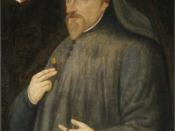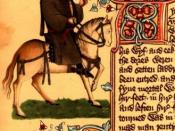Countless people believe in the cliche "do not judge a book by its cover": but why not? Clothing often forms another's first impression of one. It speaks of where a person has been and where they intend to go. Their
appearance also illustrates a person's true self and spirations. A man wearing torn jeans, dingy shirt, and old shoes might be thought of as poor or coming home from a hard day's labor. However, a young woman in a Gucci dress with Versace pumps could be assumed to have access to a large amount of money. In "The Prologue from the Canterbury Tales," Chaucer uses clothing as an insight into people's ongoing adventure called life.
In the Prologue, humbled by his life experiences, the Knight dresses plainly. Garbed in a stained coarse cotton tunic, the knight sits upon his horse. Seen in a different setting, the Knight's attire would say little about his life as an honorable man.
By humbling oneself, a true hero lends credence to the fact that flash is not always needed. His armor left dark smudges on his tunic. Humbling experiences cause humans to step back and analyze the fortune they have; they learn that they do not have to wear their achievements. Sometimes people boast their success through fine clothing. Unlike the flamboyant Yeomen, the distinguished knight wears old garments.
The Yeomen succumbs to society's inclination that when he dresses the part he will become successful. He wears a coat with a green hood. From a low social standing, he believes that the better he looks the more successful he will become. Emphasis should be placed on one's achievements and inner self rather than outward appearance. A saucy brace is worn on his arm to protect it from the bow. At first glance,


